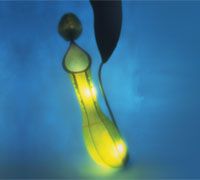Fatal flora
In the forests of Borneo in South-East Asia, a carnivorous pitcher plant, Nepenthes rafflesiana, lures, traps and digests small animals, mainly insects. As part of the lure, the pitchers copy flowers in a variety of ways, producing nectar as well as using bright colours and ultraviolet patterns. A study published in the Journal of Ecology has shown that this mimicry also includes a range of floral scents to trick insects to their demise.

In the forests of Borneo in South-East Asia, a carnivorous pitcher plant, Nepenthes rafflesiana, lures, traps and digests small animals, mainly insects. As part of the lure, the pitchers copy flowers in a variety of ways, producing nectar as well as using bright colours and ultraviolet patterns. A study published in the Journal of Ecology1 has shown that this mimicry also includes a range of floral scents to trick insects to their demise.
When observing the plants in the wild, researchers noted that the upper or aerial pitchers attracted a range of flying insects, those that typically visit flowers, while the pitchers at ground level mainly captured ants. Providing the insects with a control compartment or a compartment containing the scents of freshly cut pitchers, researchers observed that in the absence of any visual stimulus, the insects preferred to visit the odorant compartment.Analysis of the volatile compounds from the traps by GC–MS revealed benzene and terpene compounds, commonly emitted by pollinating flowers, together with a large quantity of rare compounds with sweet and sugary odours.
1. B. Di Giusto et al., J. Ecology, on-line 28 April 2010.
This story originally appeared in The Column. Click here to view that issue.

Thermodynamic Insights into Organic Solvent Extraction for Chemical Analysis of Medical Devices
April 16th 2025A new study, published by a researcher from Chemical Characterization Solutions in Minnesota, explored a new approach for sample preparation for the chemical characterization of medical devices.
Sorbonne Researchers Develop Miniaturized GC Detector for VOC Analysis
April 16th 2025A team of scientists from the Paris university developed and optimized MAVERIC, a miniaturized and autonomous gas chromatography (GC) system coupled to a nano-gravimetric detector (NGD) based on a NEMS (nano-electromechanical-system) resonator.
Miniaturized GC–MS Method for BVOC Analysis of Spanish Trees
April 16th 2025University of Valladolid scientists used a miniaturized method for analyzing biogenic volatile organic compounds (BVOCs) emitted by tree species, using headspace solid-phase microextraction coupled with gas chromatography and quadrupole time-of-flight mass spectrometry (HS-SPME-GC–QTOF-MS) has been developed.
A Guide to (U)HPLC Column Selection for Protein Analysis
April 16th 2025Analytical scientists are faced with the task of finding the right column from an almost unmanageable range of products. This paper focuses on columns that enable protein analysis under native conditions through size exclusion, hydrophobic interaction, and ion exchange chromatography. It will highlight the different column characteristics—pore size, particle size, base matrices, column dimensions, ligands—and which questions will help decide which columns to use.











